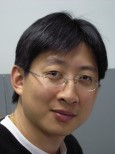李心予 Hsinyu Lee
台大生科系 教授
台大動物所 教授
台大生技中心 教授
台大 副國際長
台大國際教育中心 主任
筑波大學 訪問教授
08/12- : Professor, Department of Electrical Engineering, NTU
08/12- : Visiting Professor SIGMA, Tsukuba University, Japan
02/12- : Director Center for International Education, NTU
08/11- : Associate Dean Office of International Affairs, National Taiwan University
12/10- : Research Scientist, Center of Biotechnology, National Taiwan University.
08/09- : Professor, Department of Life Science and Institute of Zoology, NTU
主要研究領域:
細胞生物學、分子生物學、內分泌學Major Research Areas:
Cell biology, molecular biology and endocrinology研究領域摘要:
本實驗室以生物之血管內皮細胞為研究工具,研究各式與血管生成或功能有關聯之生理現象,如:發炎、血管硬化及癌症等等。 目前我們之研究主題是探討小分子水解磷酸脂 Lysophosphotidic Acid (LPA)與 Sphingosine 1-Phsophate (S1P) 及其相對應之Edg族接受器在內皮細胞中之功能及可能之病理模式。
近年來,由於許多疾病之生成都發現與血管之不正常增生有十分緊密的關聯,於是血管生成的機制及其調控成為十分重要之研究課題。 而新生血管的生成步驟,則是同時受到了正向與負向調控物質的嚴密調節。 血管生成因子的功能測試,則是以其對於血管內皮細胞的複製、移行及蛋白質酵素之活化作為測試的指標。水解磷酸脂, 包括了 LPA及 S1P,均可刺激血管內皮細胞之複製及移行,符合了成為血管生成調節因子的條件。 而由於其接受器之發現,水解磷酸脂正是自前剛啟蒙且十分受到重視的控制血管生成的可能因子。
本實驗室之研究目的,在於使我們對水解磷酸脂在控制血管生成及內皮細胞生理機制上有更進一步的瞭解。 此外,我們的研究成果對於往後以控制血管生成為目的之臨床研究應可提供重要的知識基礎。
Research Summary:
In our laboratory, we use human endothelial cell as model system to investigate the molecular and physiological functions of lysophospholipids, LPA and S1P. Results published by our laboratory and also by others suggested that LPLs might be important regulators of blood vessel formation. In our recent observations, we found that LPLs are potent stimulators for the expression of cell adhesion molecules and chemotatic factors of endothelial cells. Our results suggest that LPL might play important roles in regulating endothelial cell functions.
In addition, we also generated cell lines that are sensitive to dioxin-like compounds. We attempted to use the generated cell lines to setup a biological detection system to sensitively determine the concentrations of these toxic compounds in different sample sources.

-
B.S.
NTU, 1987 -
Ph.D.
美國加州大學舊金山分校博士 , 1998
-
Address
Room 504, ,
National Taiwan University,
Taipei 106, Taiwan -
Phone
+886-2-33662499 -
Email:

-
Office Hour
By appointment. -
Personal Homepage
http://www.lifescience.ntu.edu.tw/2010c/faculty/Lee_H.html